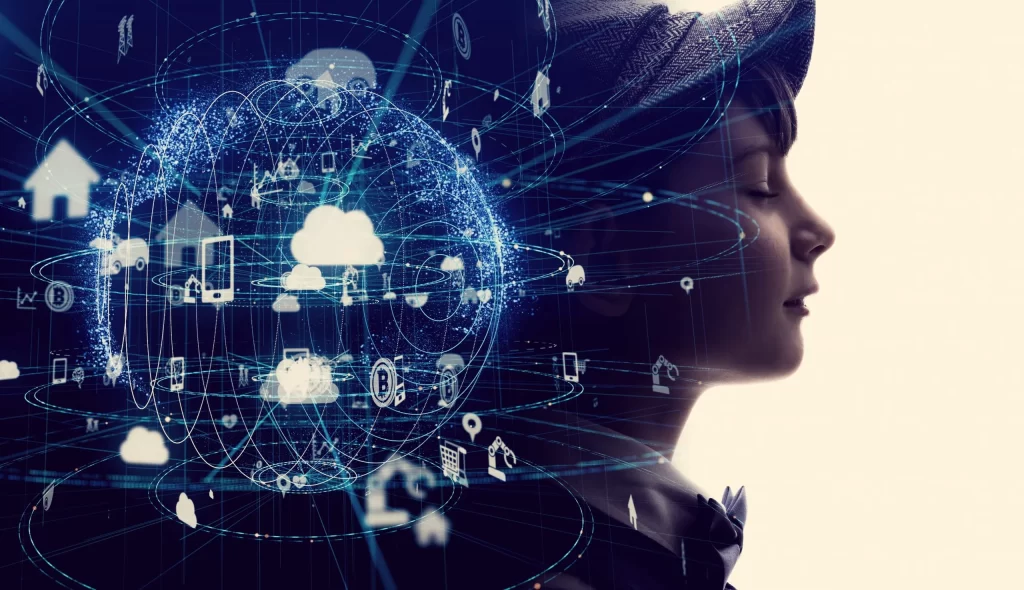Predicting the future of technology is a challenge.
We cannot accurately foresee what lies ahead. However, our history shows that technology initially had minimal impact on our lives due to its limited reach and adoption.
Yet, it gradually gained momentum and suddenly became ubiquitous. Now, we see technology all around us – it was slow at first and then completely sudden. Its growth has followed an exponential trend, accelerating over time and leaving a profound imprint on society. Now, technology has been growing faster and faster, and the impact of technology is even more rapid.
Technology today embeds various aspects of our everyday lives, and its future expansion is difficult to predict, but it will undoubtedly evolve. In the future, we may see technology being even more completely incorporated into our lives, perhaps merging with our stream of consciousness.
Furthermore, how humans interact with computers may alter dramatically, moving beyond traditional input techniques such as finger and thumb touch and incorporating advanced interfaces such as invasive or non-invasive brain-computer interfaces.
Considering the future of work, technology is poised to bring about a massive and transformative impact on industries. It is conceivable that we will form partnerships with technology in more immersive and interactive ways, forging a closer relationship between humans and machines.
What Is the Metaverse?

The concept of the metaverse isn’t well understood due to its two distinct interpretations or versions.
Firstly, there is the speculative metaverse depicted in science fiction. It envisions a future where the internet evolves into a singular, immersive experience, serving as a comprehensive platform for conducting life and enabling the creation of multiple virtual worlds and experiences.
On the other hand, the current version of the metaverse takes a different form. We are witnessing the emergence of multiple 3D immersive worlds called the metaverse. These worlds are accessed through virtual reality (VR) and augmented reality (AR) technologies. In VR, users wear headsets to enter a three-dimensional environment, utilizing interfaces like keyboards and voice commands to navigate and interact with others. AR, on the other hand, overlays digital elements in the real world. AR isn’t fully immersive. In AR, we look at reality as it stands and superimpose a computing interface into that reality.
When combined, AR and VR constitute what is known as spatial computing. The metaverse, leveraging the tools of spatial computing, aims to create an experience where users feel like they are truly immersed in an alternate world.
During the COVID-19 pandemic, when social distancing measures were in place, the metaverse provided a portal that transcended physical boundaries. It allowed people to connect and interact regardless of their physical location as long as they accessed the same system. In essence, the metaverse introduced the concept of delocalization, offering intriguing possibilities for human experiences and interactions.
“You can imagine a future where artificial intelligence is creating worlds faster than we can consume them; that would be a vision of a future metaverse.”
What Is Blockchain Technology?

At its core, blockchain technology is a distributed record that exists in multiple locations. Whenever a change is made to the record somewhere, it synchronizes somewhere else.
Presently, there is a movement towards building what is referred to as Web 3, the latest version of the Internet. Web 3 aims to dissolve centralized control and promote a distributed framework. Blockchain plays a crucial role in Web 3 by providing a part to store records securely.
A significant factor contributing to the excitement surrounding the metaverse is non-fungible tokens (NFTs). These are blockchain-based assets with unique identifiers. NFTs cannot be replicated or exchanged, as each asset has only one version tied to each asset on any given blockchain Web 3, blockchain, and the metaverse. There is a link between Web 3, blockchain, and the metaverse, which synergizes with NFTs being traded within metaverses.
For example, in a metaverse, you could purchase a unique asset like a piece of artwork and exhibit it in a virtual home that others can visit. In the future, the metaverse could become so immersive that individuals may spend more time there than in physical reality, facilitated by virtual reality (VR) and augmented reality (AR) technologies. This prospect contributes to the perceived value of NFTs.
In the digital realm, one’s reach extends beyond the limitations of physical reality. Companies will have the opportunity to create, produce, and sell their products within the metaverse. In such a scenario, the concept of a virtual private banker becomes possible.
“As metaverses are established, they may not be the creation of a single organization but rather the result of distributed collaboration of people in a decentralized way. Blockchain can be utilized for asset purchasing within metaverse environments to provide access to specific features and facilitate financial transactions.”
The Future of Artificial Intelligence and Robotics
The future of robotics and artificial intelligence (AI) is a dynamic and fast-forward domain. There are strong interconnections between the two worlds.
Traditionally, we associate robots with physical entities, while AI is often perceived as an internal component of computer systems. However, these concepts are intricately interlinked. For instance, AI can be implemented within a robot through software that aids in navigating its surroundings – – that would be AI within a robot.
On the other hand, you may have a robot that doesn’t exist in the real world; it exists in software as a simulation.
Integrating robotics and AI will significantly impact our approach to daily tasks. Much of our work has already been automated, but in the future, we will move away from explicitly instructing programs on performing tasks. Instead, machine learning and data-driven approaches will enable systems to learn and adapt autonomously. This transition will lead to a more seamless and integrated work environment.
Consider the example of mining. By employing overhead cameras to capture footage of the earth, we can optimize the allocation of resources. Leveraging AI, we can effectively utilize limited resources, identify optimal mining sites, and better understand the mining lifecycle.
“The essence of this field lies in continuous improvement and optimization. AI can be employed across various domains to enhance efficiency wherever opportunities arise.”
Human-Computer Interaction
Human-computer interaction (HCI) is a technology field that encompasses how humans interact with computers.
Since the advent of computers, HCI has been instrumental in providing inputs to generate desired outputs. Initially, this interaction took the form of punch cards, but in today’s era, it primarily occurs through smartphones, often utilizing our thumbs for input. However, this approach still has its limitations, being relatively slow and offering a low bandwidth for transmitting information.
Looking ahead, HCI is expected to undergo significant advancements, resulting in a faster and more seamless interaction between humans and machines. The boundary between us and computers will blur as new approaches develop. For instance, we can envision HCI systems near or within our brains, capable of non-invasive or invasive measurement of neurological activity to transmit information back to computers.
For example, a noteworthy research project at Wits explored utilizing the human eye and the vestibular ocular reflex. This reflex allows us to focus our gaze on a specific point without moving our heads or bodies. Exploiting this evolutionary trait, using the vestibular ocular reflex, a head-mounted camera was employed to track the user’s eye movements and enable the natural dragging of a mouse cursor on a computer screen.
“In the future, it is highly likely that HCI will accelerate, creating a more fluid and integrated interaction between humans and machines, ultimately blurring the boundaries that currently separate us.”
What Does the Future Hold?
The future holds the potential for technology to seamlessly integrate into our lives, dissolving the barriers between us and the devices we interact with.
In this envisioned future, our interaction with technology would be so natural that we wouldn’t need to manipulate it to interact with the technology itself consciously. Instead, it would effortlessly adapt to our needs and seamlessly integrate into our daily routines. This transformation has the potential to create an experience that is truly magical and awe-inspiring.
As technology progresses, the most remarkable advancements often appear to us as if they were magical. The best technologies have a way of captivating our imagination and pushing the boundaries of what we thought was possible.
“The best technologies look like magic to us.”
FAQ’s – Frequently Asked Questions
1. What drives progress in smarter technologies?
Progress is driven by continuous advancements in computational power, as well as our growing understanding of human behavior, wants, and aspirations. Researchers and engineers collaborate to develop new solutions and improve old ones using insights from domains such as psychology, anthropology, and cognitive science. This emphasis on the human experience drives the development of more intuitive and useful technology.
2. How does smart technology help us?
Smart technologies make our lives more convenient and enjoyable in many ways. Devices like smartphones keep us connected to loved ones anywhere, anytime. Smart assistants simplify tasks like scheduling, shopping, and getting information. Smart home devices automate chores and provide security and entertainment features. Technologies also enhance learning and work, boosting productivity and creativity
3. What is IoT, and how can it help?
The Internet of Things connects devices like appliances, vehicles, and industrial equipment to the Internet. This enables remote monitoring and control of systems from any location. IoT also collects usage data to provide personalized experiences. Smart cities, healthcare, energy, and transportation benefit from optimized resource usage, reduced costs, and improved services through IoT integration.
4. How else can advanced technology benefit us?
New technologies are revolutionizing fields like biotechnology, nanotechnology, AI, and robotics. This leads to better disease diagnosis, personalized treatment plans, and longer lifespans. Transportation is upgraded through connected vehicles, advanced traffic systems, and flying cars. Technologies also enhance sustainability, emergency response, and national security through climate monitoring, disaster forecasting, and border protection applications.
5. How can modern tech support sustainability?
Innovations support individuals and organizations in making greener choices. Smart grids paired with renewable energy sources enable conservation. Agricultural technologies increase crop yields while reducing waste, water usage, and emissions. IoT optimizes manufacturing and supply chain efficiencies. Electric vehicles and alternative fuels lower emissions. Technologies also empower advocacy and education for sustainability through access to research and awareness campaigns online.

